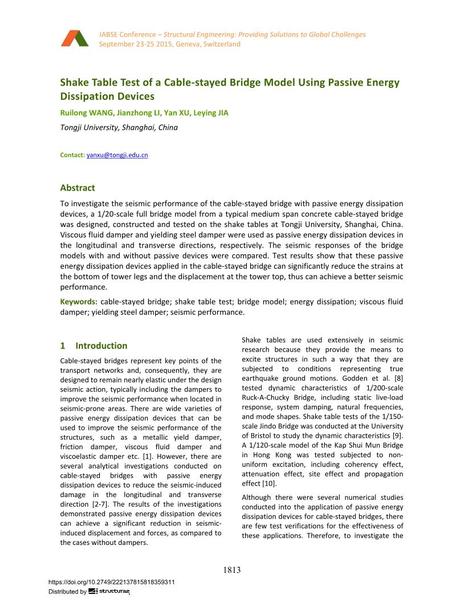Shake Table Test of a Cable-stayed Bridge Model Using Passive Energy Dissipation Devices

|
|
|||||||||||
Bibliographic Details
| Author(s): |
Ruilong Wang
(Tongji University, Shanghai, China)
Jianzhong Li (Tongji University, Shanghai, China) Yan Xu (Tongji University, Shanghai, China) Leying Jia (Tongji University, Shanghai, China) |
||||
|---|---|---|---|---|---|
| Medium: | conference paper | ||||
| Language(s): | English | ||||
| Conference: | IABSE Conference: Structural Engineering: Providing Solutions to Global Challenges, Geneva, Switzerland, September 2015 | ||||
| Published in: | IABSE Conference Geneva 2015 | ||||
|
|||||
| Page(s): | 1813-1820 | ||||
| Total no. of pages: | 8 | ||||
| Year: | 2015 | ||||
| DOI: | 10.2749/222137815818359311 | ||||
| Abstract: |
To investigate the seismic performance of the cable-stayed bridge with passive energy dissipation devices, a 1/20-scale full bridge model from a typical medium span concrete cable-stayed bridge was designed, constructed and tested on the shake tables at Tongji University, Shanghai, China. Viscous fluid damper and yielding steel damper were used as passive energy dissipation devices in the longitudinal and transverse directions, respectively. The seismic responses of the bridge models with and without passive devices were compared. Test results show that these passive energy dissipation devices applied in the cable-stayed bridge can significantly reduce the strains at the bottom of tower legs and the displacement at the tower top, thus can achieve a better seismic performance. |
||||
| Keywords: |
cable-stayed bridge seismic performance energy dissipation shake table test bridge model viscous fluid damper yielding steel damper
|
||||

